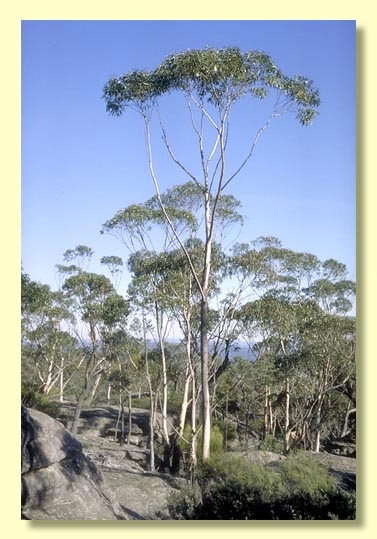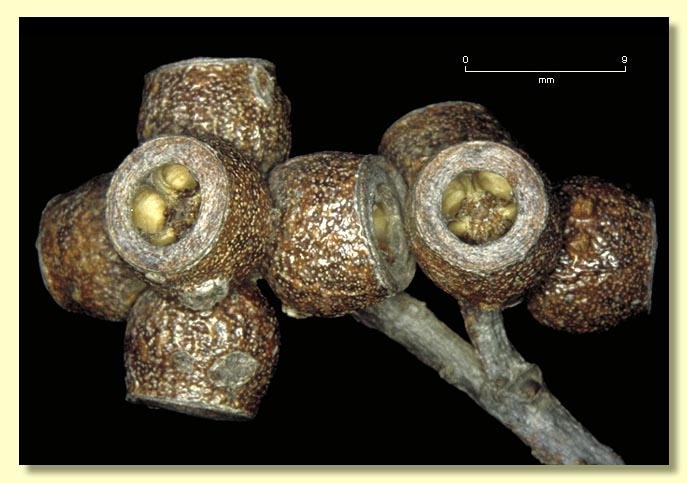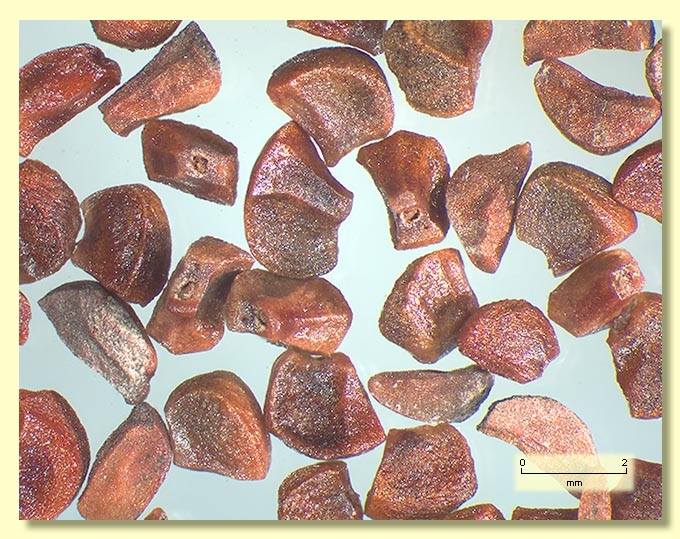Euclid - Online edition
Eucalyptus triflora
Eucalyptus | Eucalyptus | Eucalyptus | Strictae | Irregulares
Eucalyptus virgata var. triflora Maiden, Forest Fl. New South Wales 3: 87 (1907); E. fraxinoides var. triflora (Maiden) Maiden, Crit. Revis. Eucalyptus 4: 301 (1919). T: Pigeon House Mtn near Milton, NSW, Dec. 1899, R.H.Cambage s.n.; holo: NSW.
Bark smooth throughout or, for the largest trees, with some compact, dark grey, rough bark at the base of the trunk; smooth bark white to cream or yellow-grey, with scribbles, the stems and crowns ribbony.
Juvenile growth (coppice or field seedlings to 50 cm): stem rounded in cross-section, very warty on lower stem; juvenile leaves sessile, opposite and elliptical for about 3 to 5 pairs then becoming petiolate and alternate, lanceolate to falcate, 4–11 cm long, 1.5–4 cm wide, base rounded or tapering to petiole, discolorous, glossy, green.
Adult leaves alternate, petiole 0.7–1.8 cm long; blade slightly falcate to lanceolate, 7–16 cm long, 0.8–3 cm wide, base oblique or tapering to petiole, concolorous, glossy, green, side-veins acute, reticulation sparse to absent, intramarginal vein parallel to and remote from margin, oil glands irregular, island or sometimes obscure.
Inflorescence axillary unbranched, peduncles 0.3–0.7 cm long, buds 3 or occasionally 7 per umbel, sessile. Mature buds oblong, 0.7–0.8 cm long, 0.4–0.5 cm wide, green or red, warty, slightly compressed longitudinally, scar absent, operculum rounded to slightly conical, stamens irregularly flexed, anthers reniform to cordate, versatile, dorsifixed, dehiscing by confluent slits, style long, stigma blunt or tapered, locules 4(5), the placentae each with 2 vertical ovule rows. Flowers white.
Fruit sessile, urceolate to shortly barrel-shaped, 0.6–1.1 cm long, 0.7–1.2 cm wide, disc level or slightly descending, valves 4(5), near rim level or enclosed.
Seeds brown, 1.5–2 mm long, pyramidal or obliquely pyramidal, dorsal surface smooth, hilum terminal.
Cultivated seedlings (measured at ca node 10): cotyledons reniform; stems rounded in cross-section, densely warty (feel scabrid) on lower part; leaves sessile, opposite, elliptical-ovate and discolorous for 4 to 5 nodes then alternate with more obvious petioles, lanceolate 7–11 cm long, 2.5–3.5 cm wide, base rounded or tapering, apex pointed, concolorous, glossy, green.
Flowering has been recorded in January, March and December.
A small tree, endemic to New South Wales, occurring in a few disjunct, rocky, sandstone areas in the south-east from east of Nerriga south to Pigeon House and further south to parts of Deua National Park. There is an isolated stand near Yalwal near Tullyangela Creek.
E. triflora is a green-leaved ash and is notable for the three-budded inflorescences and sessile, squat buds and fruits. Bark is smooth to partly rough. It differs from the related mallee ashes by the habit and inflorescence characters. Seven-budded forms may exist in the typical populations,which shows the close relationships in the green-leaved mallee ashes.
Eucalyptus triflora belongs in Eucalyptus subgenus Eucalyptus section Eucalyptus series Strictae, because of a combination of characters: small tree habit with predominantly smooth bark, alternate, green juvenile leaves, adult leaves held erect and with acute side-veins and little or no visible reticulation, single axillary inflorescences, the buds in clusters of three or seven, with buds having only one operculum and reniform anthers, ovules in two rows, and more or less pyramidal seeds. Within series Strictae, E. triflora is one of six closely related species all with leaf oil glands that are irregular in outline (subseries Irregulares); the others are E. dendromorpha (a partly rough-barked tree with clavate buds in sevens and more elongated fruit with descending disc); E. apiculata, E. stricta and E. burgessiana (all mallees with smooth bark and clavate buds in sevens, rarely elevens); and E. langleyi (also a smooth-barked mallee but with angular branchlets, clavate buds in sevens and adult leaves to 5 cm wide). The more distantly related forest tree species, E. fraxinoides may be confused with E. triflora but it gows on better quality sites and differs in the thinner crown leaves, pedicellate buds in clusters of 7 to 11 and black seeds.














